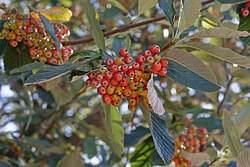Sorbus aria
| Sorbus aria subsp. var. | Whitebeam | |||||||||||||||||||||||||||||||||||||||||||||||||||||||
|---|---|---|---|---|---|---|---|---|---|---|---|---|---|---|---|---|---|---|---|---|---|---|---|---|---|---|---|---|---|---|---|---|---|---|---|---|---|---|---|---|---|---|---|---|---|---|---|---|---|---|---|---|---|---|---|---|

|
|
| ||||||||||||||||||||||||||||||||||||||||||||||||||||||
| ||||||||||||||||||||||||||||||||||||||||||||||||||||||||
Sorbus aria (syn. Aria nivea), the Whitebeam or Common Whitebeam is a deciduous tree, compact and domed, with few upswept branches; it generally favours dry limestone and chalk soils. The hermaphrodite cream-white flowers appear in May, are insect pollinated, and go on to produce scarlet berries, which are often eaten by birds.[1]
| Standard Cyclopedia of Horticulture |
|---|
|
Sorbus aria, Crantz (Pyrus Aria, Ehrh. Aria nivea, Host. Hahnia Aria, Medikus). White Beam-tree. Tree, with broadly pyramidal or oval head, 25-50 ft. high: lvs. elliptic to oblong-oval, usually cuneate at the base, acute or obtuse at the apex, sharply and doubly serrate, of firm texture, bright or dark green and glabrous above, white-tomentose beneath, 2-5 in. long; petioles 1/3 – 3/4 in. long: fls. 1/2 – 3/4 in. across, in tomentose, 2-3-in.-broad corymbs: fr. sub-globose, orange-red, about 1/2 in. high. May. Cent. and S. Eu. to Himalayas and Siberia. GM. 44:291. H.W. 3:52.—Desirable tree for dry and exposed situations, and very ornamental in foliage on account of the contrasting colors of the upper and under sides of the lvs. Var. Decaisneana, Rehd. (Aria Decaisneana, Lav. Pyrus Decaisneana, Nichols. Pyrus Aria var. majestica, Prain. S. Aria var. majestica, Zabel). Lvs. elliptic or ovate, irregularly doubly serrate, 3-7 in. long: infl. 3-4 in. across: fls. 3/4 in. across; stamens longer than styles: fr. oval, 1/2 in, across. Origin unknown, probably from the Himalayas. Var. edulis, Wenzig (Pyrus edulis, Willd. S. longifolia, Hedl.). Lvs. elliptic-oblong to oblong, rounded or acute at the apex, 2-5 in. long: fr. oval, 1/2 – 3/4 in. high. There are some garden forms, as vars. aurea, chrysophylla, and lutescens, Hort., with more or less yellow foliage. CH
|
Cultivation
Propagation
Pests and diseases
Varieties
Gallery
-
photo 1
-
photo 2
-
photo 3
References
- ↑ The Reader's Digest Field Guide to the Trees and Shrubs of Britain p.86.
External links
- w:Sorbus aria. Some of the material on this page may be from Wikipedia, under the Creative Commons license.
- Sorbus aria QR Code (Size 50, 100, 200, 500)


